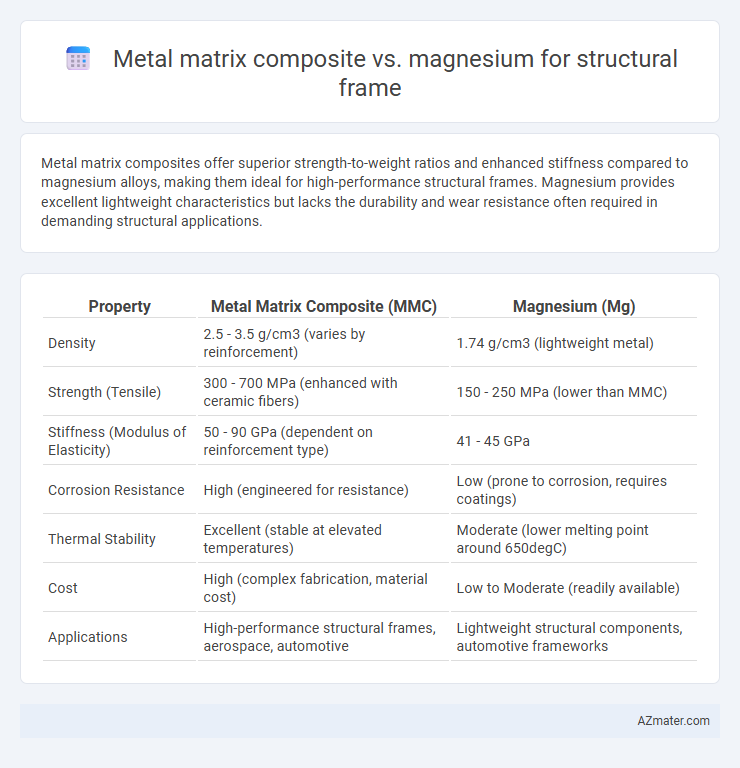Metal matrix composites offer superior strength-to-weight ratios and enhanced stiffness compared to magnesium alloys, making them ideal for high-performance structural frames. Magnesium provides excellent lightweight characteristics but lacks the durability and wear resistance often required in demanding structural applications.
Table of Comparison
| Property | Metal Matrix Composite (MMC) | Magnesium (Mg) |
|---|---|---|
| Density | 2.5 - 3.5 g/cm3 (varies by reinforcement) | 1.74 g/cm3 (lightweight metal) |
| Strength (Tensile) | 300 - 700 MPa (enhanced with ceramic fibers) | 150 - 250 MPa (lower than MMC) |
| Stiffness (Modulus of Elasticity) | 50 - 90 GPa (dependent on reinforcement type) | 41 - 45 GPa |
| Corrosion Resistance | High (engineered for resistance) | Low (prone to corrosion, requires coatings) |
| Thermal Stability | Excellent (stable at elevated temperatures) | Moderate (lower melting point around 650degC) |
| Cost | High (complex fabrication, material cost) | Low to Moderate (readily available) |
| Applications | High-performance structural frames, aerospace, automotive | Lightweight structural components, automotive frameworks |
Introduction to Structural Frame Materials
Metal matrix composites (MMCs) offer superior strength-to-weight ratios, corrosion resistance, and thermal stability compared to pure magnesium, making them ideal for advanced structural frames in aerospace and automotive industries. Magnesium, notable for its low density and high machinability, often serves in applications where weight reduction is critical but faces limitations due to lower mechanical strength and corrosion resistance. Selecting between MMCs and magnesium involves balancing performance requirements with cost, manufacturability, and environmental resilience for optimal structural frame design.
Overview of Metal Matrix Composites
Metal matrix composites (MMCs) combine a metallic matrix, such as aluminum or titanium, with reinforcing materials like ceramics or carbon fibers to enhance mechanical properties including strength, stiffness, and wear resistance. MMCs offer superior strength-to-weight ratios and thermal stability compared to pure magnesium alloys, making them ideal for lightweight structural frames in aerospace and automotive industries. Their tailored microstructure allows for improved fatigue resistance and corrosion mitigation, providing performance advantages over conventional magnesium materials.
Properties of Magnesium Alloys
Magnesium alloys offer exceptional strength-to-weight ratios, corrosion resistance, and excellent machinability, making them advantageous for structural frame applications where lightweight materials are crucial. Metal matrix composites (MMCs), while providing superior stiffness, wear resistance, and thermal stability compared to pure magnesium, often come at a higher cost and complexity in manufacturing. The inherent damping capacity and lower density of magnesium alloys enhance vibration control and reduce overall frame weight, critical for automotive and aerospace structural components.
Strength-to-Weight Ratio Comparison
Metal matrix composites (MMCs) exhibit a significantly higher strength-to-weight ratio compared to magnesium alloys, making them ideal for structural frame applications requiring enhanced performance and durability. While magnesium offers low density and good corrosion resistance, MMCs combine lightweight metal matrices with ceramic reinforcements, resulting in superior tensile strength and stiffness without substantial weight increase. This advantageous balance of mechanical properties in MMCs leads to improved load-bearing capacity and fuel efficiency in automotive and aerospace structural frames.
Corrosion Resistance and Durability
Metal matrix composites (MMCs) exhibit superior corrosion resistance compared to magnesium alloys, owing to their enhanced protective oxide layers and tailored reinforcement phases that reduce oxidation and material degradation. Magnesium, while lightweight and possessing good strength-to-weight ratio, is more susceptible to galvanic corrosion and environmental wear, especially in humid or saline conditions. Durability of MMCs surpasses magnesium due to improved fatigue resistance and dimensional stability under mechanical and thermal stresses, making MMCs preferable for long-term structural frame applications.
Manufacturing and Processing Techniques
Metal matrix composites (MMCs) offer enhanced mechanical properties and corrosion resistance compared to pure magnesium, making them suitable for structural frames requiring high strength-to-weight ratios. Manufacturing techniques for MMCs include powder metallurgy, stir casting, and squeeze casting, which enable uniform reinforcement distribution and improved microstructural control. Magnesium processing involves methods like die casting and extrusion, valued for simplicity and cost-effectiveness, but often faces challenges in achieving the same wear resistance and stiffness as MMCs.
Cost Analysis and Economic Considerations
Metal matrix composites (MMCs) offer superior strength-to-weight ratios and corrosion resistance compared to magnesium, but their production costs are significantly higher due to complex fabrication processes and expensive reinforcement materials like ceramic fibers. Magnesium remains economically favorable for structural frames because of its low material cost, ease of machining, and established supply chains, despite lower mechanical performance and higher susceptibility to corrosion. Evaluating overall project budgets requires balancing MMCs' long-term durability and performance benefits against magnesium's initial affordability and cost-effective manufacturing.
Applications in Automotive and Aerospace
Metal matrix composites (MMCs) offer superior strength-to-weight ratios and enhanced thermal stability compared to magnesium alloys, making them ideal for critical automotive and aerospace structural frames requiring high performance under stress. MMCs exhibit improved wear resistance and stiffness, which contribute to longer component life and better fuel efficiency in aircraft and high-performance vehicles. Magnesium provides excellent lightweight properties and cost-effectiveness but falls short in durability and load-bearing capabilities compared to MMCs in demanding structural applications.
Environmental Impact and Sustainability
Metal matrix composites (MMCs) offer enhanced strength-to-weight ratios compared to pure magnesium, resulting in longer-lasting structural frames and reduced material consumption, which lowers environmental impact through resource efficiency. Magnesium's natural abundance and recyclability contribute to sustainability; however, its corrosion susceptibility and lower mechanical properties can limit lifespan and increase maintenance frequency. Utilizing MMCs with magnesium matrices improves durability and corrosion resistance, promoting extended service life and reducing environmental costs associated with frequent replacements and repairs.
Future Trends in Structural Frame Materials
Metal matrix composites (MMCs) offer superior strength-to-weight ratios and enhanced thermal stability compared to magnesium, making them increasingly favorable for future structural frame applications in aerospace and automotive industries. Innovations in nano-reinforcement and additive manufacturing are driving the development of MMCs with tailored mechanical properties, surpassing the limitations of traditional magnesium alloys. Future trends indicate a shift toward hybrid materials combining MMCs with magnesium to achieve optimal performance, corrosion resistance, and cost-efficiency in lightweight structural frames.

Infographic: Metal matrix composite vs Magnesium for Structural frame
 azmater.com
azmater.com